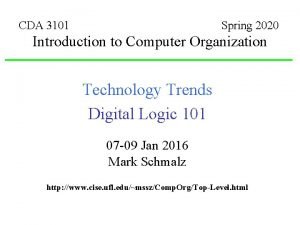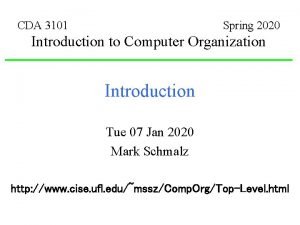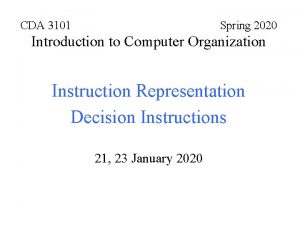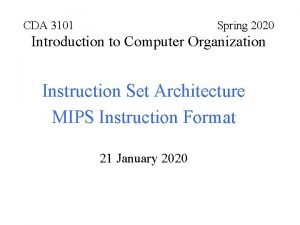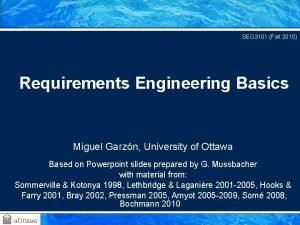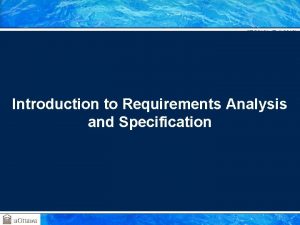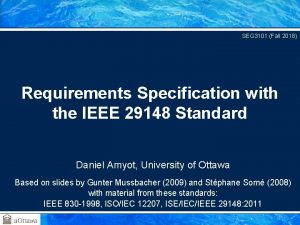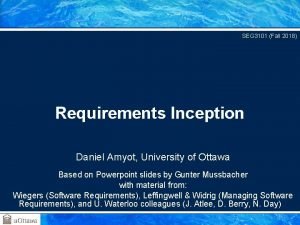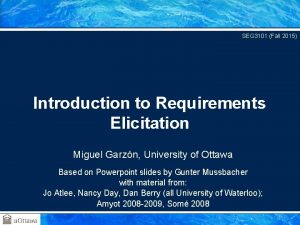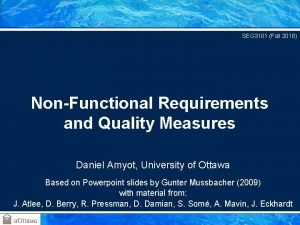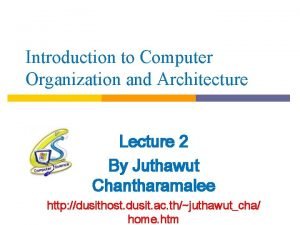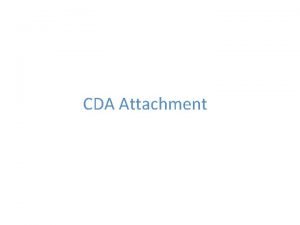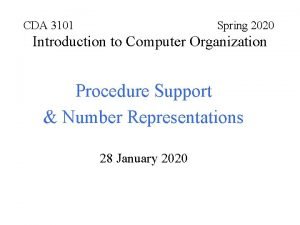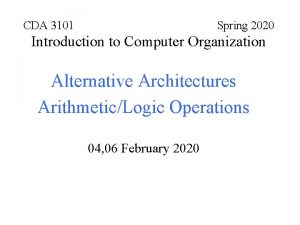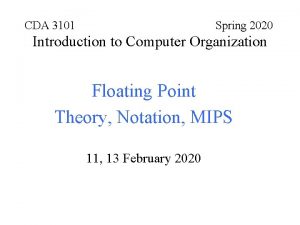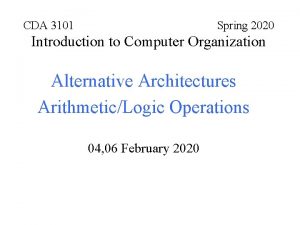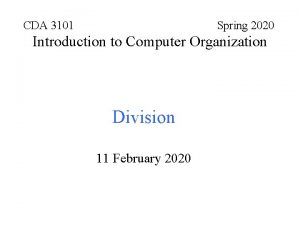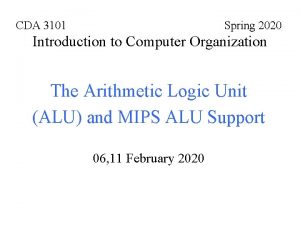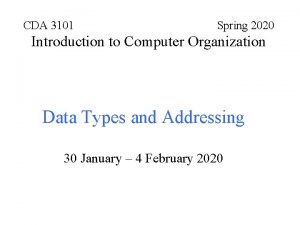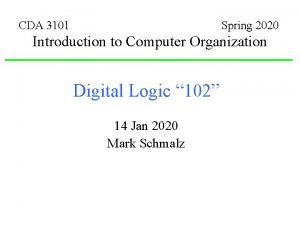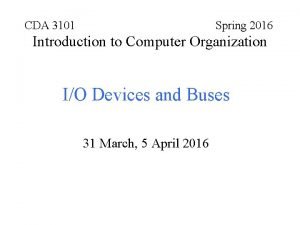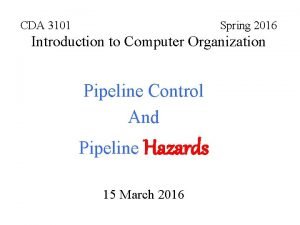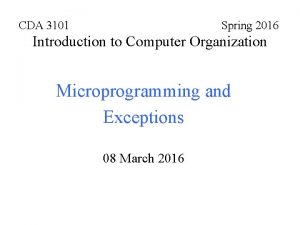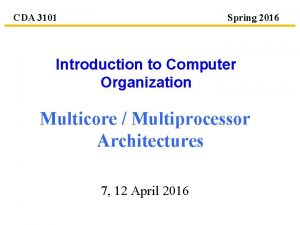CDA 3101 Spring 2020 Introduction to Computer Organization









![Levels of Representation temp = v[k]; v[k] = v[k+1]; v[k+1] = temp; High Level Levels of Representation temp = v[k]; v[k] = v[k+1]; v[k+1] = temp; High Level](https://slidetodoc.com/presentation_image_h/16aa3fe16e1532baaeb0367acbfe6f14/image-10.jpg)










- Slides: 20

CDA 3101 Spring 2020 Introduction to Computer Organization Introduction Tue 07 Jan 2020 Mark Schmalz http: //www. cise. ufl. edu/~mssz/Comp. Org/Top-Level. html

Overview • Introduction to CDA 3101 • Course overview • Housekeeping details • Computer abstraction • Anatomy of a computer • Conclusion

Introduction • Rapidly changing field: – vacuum tube -> transistor -> IC -> VLSI (see Section 1 of text) – doubling approximately every 1. 5 years (Moore’s law): • Memory capacity • Processor speed (Due to advances in technology and organization) • Things you’ll be learning: – how computers work, a basic foundation – how to analyze their performance (or how not to!) – issues affecting modern processors (caches, pipelines) • Why learn this stuff? – you want to call yourself a “computer scientist” – you want to build software people use (need performance) – you need to make a purchasing decision or offer advice

Computing System Application (Browser) Compiler Software Hardware Assembler Operating System (Win, Linux) Processor Memory I/O system CDA 3101 Instruction Set Architecture Datapath & Control Digital Design Circuit Design transistors • Coordination of many levels of abstraction

CDA 3101 Textbook: “P&H” Computer Organization and Design Patterson and Hennessy Fifth Edition Morgan Kaufmann © 2014 (MIPS) © 2017 (ARM) AVAILABLE FREE ONLINE THRU CANVAS

Course Overview • • Performance issues (Ch 1 – P&H 5 th Edition) A specific instruction set architecture (Ch 2) Arithmetic and how to build an ALU (Ch 3) Constructing a processor to execute our instructions (Ch 4) Pipelining to improve performance (Ch 4) Caches, main, and virtual memory, I/O (Ch 5) Multiprocessor Architectures (Ch 6) Future Computing Technologies (instructor)

CDA 3101 Big Ideas • 5 Classic components of a Computer • Data can be anything (integers, floating point, characters): a program determines what it is • Stored program concept: instructions just data • Principle of Locality, exploited via a memory hierarchy (cache and virtual memory) • Greater performance by exploiting parallelism • Principle of abstraction, used to build complex systems as layers • Compilation v. interpretation thru system layers • Principles/Pitfalls of Performance Measurement

Course Administration • Instructor: – Dr. Schmalz (mssz@cise. ufl. edu, CSE 446, 352 -505 -1561) • TAs: – Maksim Levental mlevental 86@cise. ufl. edu – TBD email@cise. ufl. edu • Website: www. cise. ufl. edu/~mssz/Comp. Org/Top. Level. html • Canvas site is being migrated from Website • Text: Computer Organization and Design: The Hardware Software Interface, Fifth Edition, Patterson and Hennessy

Course Evaluation • Grade breakdown – – Midterm Exam (2) Final Exam Quizzes (5) Homework Assignments (5) TOTAL 40% 420 points 25% 240 points 10% 100 points 25% 240 points 100% 1000 points FINAL GRADE: Divide TOTAL SCORE by 10, Apply UF Grading Scale • Scores posted on Canvas site (as available) – Grade changes: Work with TA – Wed 29 Apr 2020 deadline to correct online scores • No Cheating – No Curving in this Course
![Levels of Representation temp vk vk vk1 vk1 temp High Level Levels of Representation temp = v[k]; v[k] = v[k+1]; v[k+1] = temp; High Level](https://slidetodoc.com/presentation_image_h/16aa3fe16e1532baaeb0367acbfe6f14/image-10.jpg)
Levels of Representation temp = v[k]; v[k] = v[k+1]; v[k+1] = temp; High Level Language Program (e. g. , C) Compiler CDA 3101 lw $t 0, lw $t 1, sw$t 0, Assembly Language Program (e. g. , MIPS) Assembler Machine Language Program (MIPS) Machine Interpretation Control Signal Specification ° ° 0000 1010 1100 0101 1001 1111 0110 1000 1100 0101 1010 0000 0110 1000 1111 1001 0($2) 4($2) 1010 0000 0101 1100 1111 1000 0110 0101 1100 0000 1010 1000 0110 1001 1111

A Six-Level Computer

Big Idea: Multilevel Machine

Evolution of Multilevel Machines 1. 2. 3. 4. 5. Bare hardware Microprogramming Operating system Compilers Hardware / software interface – – Simple ISA CISC RISC FISC

Design Principles • CISC vs. RISC • Instructions directly executed by hardware • Maximize instruction issue rate (ILP) • Simple instructions (easy to decode) • Access to memory only via load/store • Plenty of registers • Pipelining

Computer Organization Von Neumann Machine Processor

Datapath Memory I/O

Bus-Based Computer

Anatomy of a Classic PC

Multiprocessors Local Memory

Conclusion • < 16 weeks to learn big ideas in CS/CEN – Principle of abstraction, used to build systems as layers – Pliable Data: a program determines what it is – Stored program concept: instructions are just data – Principle of Locality, exploited via memory hierarchy – Greater performance by exploiting parallelism (pipeline) – Compilation v. interpretation to move downward through layers of system – Principles/Pitfalls of Performance Measurement
 Hardware 1990 cda
Hardware 1990 cda Cda3101 uf
Cda3101 uf Cda 3101
Cda 3101 Cda3101
Cda3101 Process organization in computer organization
Process organization in computer organization Validation types
Validation types Seg 3101
Seg 3101 Ieee 29148 template
Ieee 29148 template Seg 3101
Seg 3101 Seg 3101
Seg 3101 Jeff 3101
Jeff 3101 Seg 3101
Seg 3101 Bae yong-kyun
Bae yong-kyun Summer winter fall spring months
Summer winter fall spring months Basic structure of a computer
Basic structure of a computer Computer architecture vs computer organization
Computer architecture vs computer organization Design of basic computer with flowchart
Design of basic computer with flowchart Design of basic computer
Design of basic computer Introduction to computer organization and architecture
Introduction to computer organization and architecture Introduction to computer organization
Introduction to computer organization Spring io conference 2020
Spring io conference 2020
